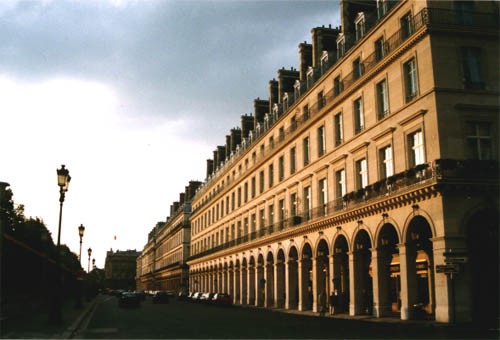The idea of driving a triumphal route through Paris from east to west
emerged during the Ancien Regime, but it was never to be realised.
Indeed the need for a main channel of communication between the
place de la Concorde and the Louvre was bitterly felt during the
revolutionary revolts around the Tuileries – and Bonaparte himself
knew the problem intimately since he was called upon to suppress the
Royalist revolt of 13 Vendémiaire, Year 6, at the church of
Saint-Roch in rue Saint-Honoré. Taking his inspiration from a
revolutionary project of 1793, Napoleon in his capacity as First
Consul issued a decree (17 Vendémiaire, year 10 – i.e., 9 October,
1801) ordering the cutting of a series of openings between the
Tuileries gardens, the place Vendôme, rue Saint-Honoré and rue
Saint-Florentin, the gardens of the convents of the Assumption, the
Capucines and the Feuillants. The new road thus created was
christened Rivoli in memory of the best-known battle of the First
Italian Campaign. The building of rue Rivoli also allowed the creation
of rue Castiglione and rue des Pyramides.
The demolition and clearing began in 1802 and already by 1803 rue
Rivoli ran from place de la Concorde to present day rue de l'Echelle,
running alongside the Tuileries gardens and palace and the Louvre. In
1804, for the coronation, the road was even paved. The architects
Percier and Fontaine were called upon to design buildings which
would harmonise with the facing park and palaces. They opted for an ordered
arrangement of façades whose originality lay in the arcades designed
to provide Parisians with an elegant place to make their promenades.
The only previous use of such an architectural form since the place
des Vosges was the rue des Colonnes in the 2nd arrondissement built
during the Directory period. On the rue de Rivoli, the dimensions
given to the ensemble gave a strong impression of severe elegance and a
rigorous grandiosity characteristic of the Neo-classicism of this
period. All the edifices were subject to the same building
regulations: there were to be three storeys, built
over a ground floor and mezzanines with arcades,
with an obligation to use stone for the facing of the
façade; the first floor was to be marked by a light modillioned
entablature with balconies bordered in wrought iron; there was to be a second,
shorter storey, with an attic and balustrade above. Only the roofs were not
regulated, a fact which led to variations which can still
be seen today. This monumentality, with its strict lines and
extraordinary perspectival effect, matched perfectly Napoleon's desire
to build a prestigious and luxurious place for promenading. And in order to
ensure its exclusivity, decrees were passed banning the setting up of
certain shops – such as butcher shops, shops requiring ovens, and shops
requiring the use of hammers – and shop signs were forbidden in
arcades.
All these constraints acted as an enormous deterrent to prospective
buyers, and so in 1811 the emperor adopted measures designed to
encourage purchasers, amongst which there was notably an exemption
from taxes for twenty years (subsequently raised to thirty).
Although by the end of the Empire only the arcades and a few
buildings had been erected, the impetus has been given and the street
was to be completed in the following regimes. The extension of the
road as far as rue Marengo was decided by the temporary government
of the Second Republic in 1848, and the legislation required
to increase its length to the level of trhe Hotel
de Ville was passed in 1851 by Assemblé
Legislative. Hausmann then took up the project and built the road to its
present end at the metro station called St Paul. Fontaine's architecture
was preserved as far as the rue du Louvre but the original obligatory building
specifications were removed for the eastern end of the street. And Victor
Hugo was to have the final word with his remarks on the modern
capital:
Le vieux Paris n'est plus qu'une rue éternelle
Qui s'étire élégante et droite comme un I
En disant : Rivoli, Rivoli, Rivoli
(Old Paris is now nothing more than one eternal road
Stretching out, with the elegant straightness of a letter 'I',
To the refrain: Rivoli, Rivoli, Rivoli)
Rue Rivoli, Paris


